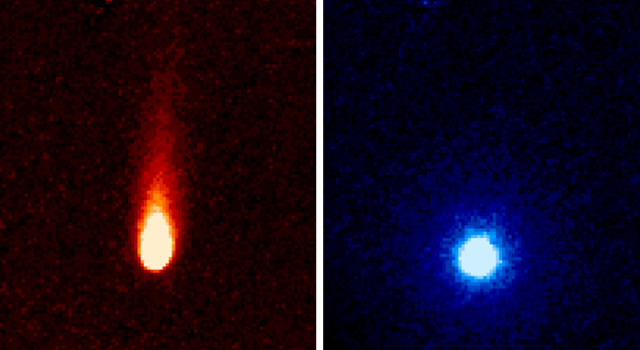As part of the Comet ISON Observing Campaign, the Spitzer Space Telescope was used to “stare” at the comet for 24 hours on Jun 13, 2013. Images from Spitzer’s “ISON-a-thon” indicate that carbon dioxide and dust are spewing out of the comet at a fairly large rate.
“We estimate ISON is emitting about 2.2 million pounds (1 million kilograms) of what is most likely carbon dioxide gas and about 120 million pounds (54.4 million kilograms) of dust every day,” said Carey Lisse, leader of NASA’s Comet ISON Observation Campaign and a senior research scientist at the Johns Hopkins University Applied Physics Laboratory.
That amount of dust is about the mass of one aircraft carrier every two days or so, tweeted the Sungrazing Comets Twitter feed,, and the amount of carbon dioxide released per day would be enough for about 625 million cans of soda.
The images were taken by the Spitzer’s Infrared Array Camera showing the comet’s tail, which is about 186,400 miles (300,000 kilometers) long.
Comet ISON was about 312 million miles (502 million kilometers) from the Sun, 3.35 times farther than Earth, when the observations were made.
Comet ISON (C/2012 S1) is less than 3 miles (4.8 kilometers) in diameter (about the size of a small mountain) and weighs between 7 billion and 7 trillion pounds (3.2 billion and 3.2 trillion kilograms). However, its true size and density have not yet been accurately determined because of its distance from Earth. Like all comets, ISON is a dirty snowball made up of dust and frozen gases such as water, ammonia, methane and carbon dioxide. These are some of the fundamental building blocks, which scientists believe led to the formation of the planets 4.5 billion years ago.
“This observation gives us a good picture of part of the composition of ISON, and, by extension, of the proto-planetary disk from which the planets were formed,” said Lisse. “Much of the carbon in the comet appears to be locked up in carbon dioxide ice. We will know even more in late July and August, when the comet begins to warm up near the water-ice line outside of the orbit of Mars, and we can detect the most abundant frozen gas, which is water, as it boils away from the comet.”
The comet will pass within 724,000 miles (1.16 million kilometers) of the Sun on Nov. 28.
Astronomers are wondering if the comet will survive its close pass of the Sun, and also if it will live up to expectations of becoming bright enough to be seen in the daytime, as some have predicted.
Only time will tell … and we’ll be here to share the news.
Source: JPL


Waiting for your update news. It is my interesting field
Most exciting IMO is the fact that they now believe this to be a virgin comet on it’s maiden journey into the inner gravity well. A pristine fragment of the stuff from which our system of planetary bodies formed, as you mentioned above, Nancy. I hope the science is fantastic even if the light show fizzles out.
I’ll bet this “dirty snowball” will melt like snow before the sun. Or not?
Thanks for the update Nancy! I can’t wait to see this one and plan to start looking ASAP!
From NASA’s Solar System Exploration page:
“Beginning in late August, astronomers will be able to observe the comet through ground-based telescopes once again. From early June through late-August, ISON was almost directly behind the sun as viewed from Earth, and thus could not be observed from the ground.”
AND: “In September, the comet will be visible near dawn in the Southern Hemisphere with binoculars”
So… it’s looks like we’ll (Northern Hemisphere amateurs) just have to wait until AFTER perihelion on Thanksgiving Day. Nov. 28th… OR travel to the southern hemisphere in late August to see this puppy?